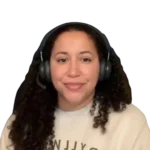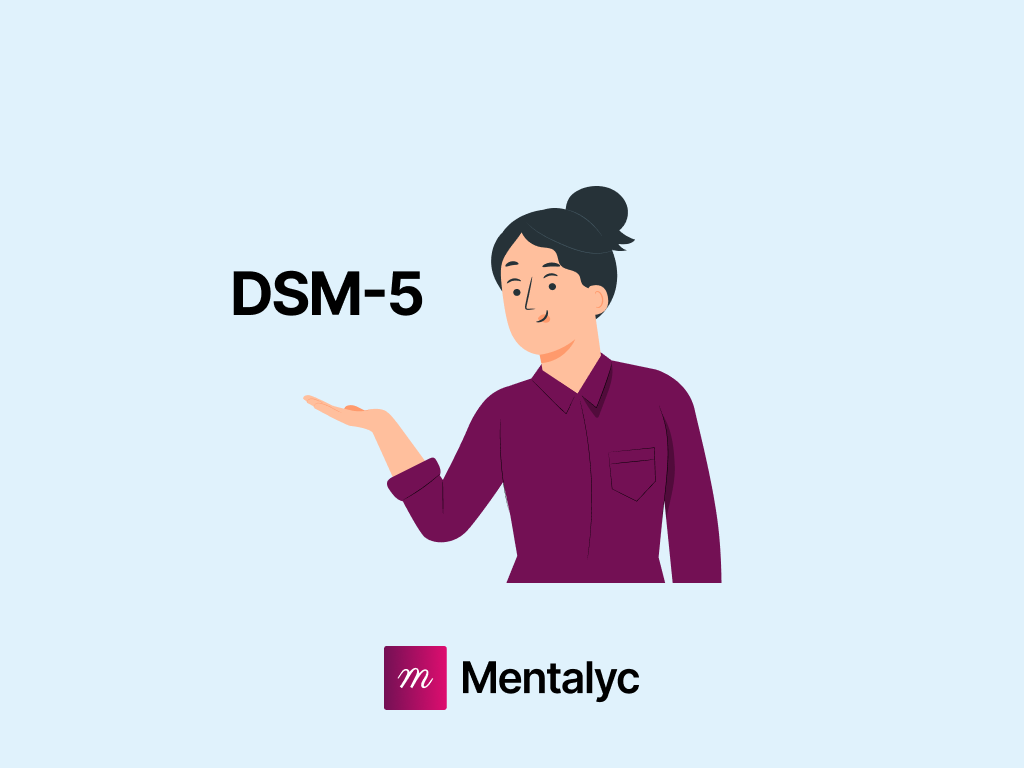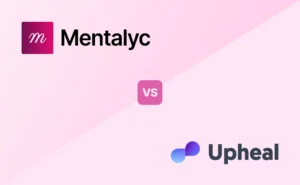You may feel confident in your counseling skills, but even experienced therapists admit that the Diagnostic and Statistical Manual-5th Edition (DSM-5) can be tough to keep straight in daily practice. Between shifting criteria, new DSM-5-TR diagnostic codes, and pages of detailed descriptions, it’s easy to feel bogged down. Many clinicians say the challenge isn’t knowing what the DSM is for, but being able to quickly pull up the right code or criteria when it really matters.
This cheat sheet contains succinct descriptions of the most common diagnoses, accompanying codes, symptoms, and tips. It will be your go-to desk reference for all things DSM-5-TR. Whether you need a quick reference during sessions or while advising colleagues, this guide covers you. By mastering the fundamentals, you can gain confidence in your diagnoses and reduce the time you’d otherwise spend thumbing through the entire manual
Pairing this DSM-5-TR cheat sheet with a tool like Mentalyc means you not only find the right diagnosis faster, but you also have the tools to document, track, and prove progress effortlessly.
👉 Keep reading for the full breakdown of the DSM-5 essentials – so the next time you need a code or symptom list, you’ll have it at your fingertips.
The DSM-5-TR’s Intentional Structure
Have you ever considered how this vast collection of diagnostic criteria and classifications came to be? The structure and organization of the DSM-5-TR are intricate and purposeful, designed to aid clinicians in accurate diagnosis while encompassing a wide range of psychiatric conditions.
First, Section I – Introduction provides essential general information about using the manual effectively. It also includes instructions for making diagnoses based on specific criteria outlined throughout.
Next comes Section II – Diagnostic Criteria and Codes, arguably one of the most crucial parts. Here, you’ll find an extensive list of mental disorders classified under 20 distinct categories – from neurodevelopmental disorders to schizophrenia spectrum disorders – each defined by specific symptoms required for diagnosis.
Finally, Section III – Emerging Measures and Models introduces potential alternative models or measures that are still undergoing research but may shape the content of future editions.
Breaking Down Common DSM-5-TR Codes and Diagnoses
| Disorder | DSM-5-TR Diagnostic Code | Key Symptoms (DSM-5 Criteria Summary) |
| Major Depressive Disorder (MDD) | 296.2x, 296.3x | Depressed mood, loss of interest, changes in sleep/appetite, guilt, poor concentration, suicidal ideation. |
| Generalized Anxiety Disorder (GAD) | 300.02 | Excessive worry, restlessness, fatigue, irritability, sleep disturbance, muscle tension. |
| Posttraumatic Stress Disorder (PTSD) | 309.81 | Intrusive memories, flashbacks, avoidance, negative mood/cognitions, hyperarousal. |
| Bipolar Disorder | 296.0x, 296.4x–296.7 | Manic episodes (elevated mood, impulsivity), possible depressive episodes, functional impairment. |
| Schizophrenia | 295.xx | Delusions, hallucinations, disorganized speech, negative symptoms, impaired functioning. |
| Attention-Deficit/Hyperactivity Disorder (ADHD) | 314.00, 314.01 | Inattention, hyperactivity, impulsivity, symptoms present before age 12, across multiple settings. |
Some of the most commonly diagnosed mental illnesses and their ICD-10 codes include:
- Major Depressive Disorder (296.2x-3x)
- Generalized Anxiety Disorder (300.02)
- Posttraumatic Stress Disorder (PTSD) (309.81)
- Bipolar Disorder (296.0x, 296.4x, 296.5x, 296.6x, 296.7)
- Schizophrenia (295. xx)
- Attention-Deficit/Hyperactivity Disorder (314.00, 314.01)
To properly diagnose someone, you must determine if they exhibit the typical symptoms associated with the disorder you’re considering. These symptoms can include a wide range of things, such as changes in mood, behavior, or thought patterns. This mental health diagnosis guide can help you quickly compare disorders when the criteria overlap.

Below are some of the most common criteria and symptoms that you may face, serving as a DSM-5 criteria summary for clinicians:
Major Depressive Disorder
- Feeling depressed or sad most of the day, nearly every day.
- Loss of interest in activities once enjoyed.
- Changes in appetite and sleep.
- Difficulty concentrating or making decisions.
- Feelings of worthlessness or guilt.
- Recurrent thoughts of death or suicide.
Generalized Anxiety Disorder
- Excessive anxiety and worry occur most days for at least six months.
- Difficulty controlling the worry.
- At least three of the following symptoms: restlessness, fatigue, difficulty concentrating, irritability, muscle tension, and sleep problems.
Posttraumatic Stress Disorder
- Exposure to actual or threatened death, serious injury, or sexual violence.
- Intrusive symptoms such as distressing memories, dreams, or flashbacks.
- Avoiding reminders of the traumatic event.
- Adverse changes in thoughts and mood, such as distorted cognitions and persistent negative emotional state.
- Changes in arousal and reactivity, including irritable behavior and hypervigilance.
Bipolar Disorder
- Manic episodes: abnormally elevated or irritable mood, increased activity, energy, and impulsiveness. Lasts at least one week.
- Hypomanic episodes: less severe than manic episodes. Lasts at least four days.
- Major depressive episodes: depressed mood, loss of interest in activities, changes in sleep and appetite. Lasts at least two weeks.
- Treatment focuses on mood stabilizers, antipsychotics, and psychotherapy.
Schizophrenia
- Delusions: false beliefs that cannot be changed by reason. Present for a significant portion of time during one month (or less if successfully treated).
- Hallucinations: seeing, hearing, feeling, tasting, or smelling something that does not exist. Lasts approximately one month (or less if successfully treated).
- Disorganized speech: incoherent or irrelevant speech. Present for a considerable duration during one month (or less if successfully treated).
- Grossly disorganized or abnormal motor behavior.
- Negative symptoms: diminished emotional expression, lack of pleasure in everyday life, inability to start and sustain planned activities.
Attention-Deficit/Hyperactivity Disorder
- In attention, such as being easily distracted or making careless mistakes.
- Hyperactivity and impulsivity include fidgeting, inability to remain seated, and interrupting others.
- Symptoms present in multiple settings like school and home.
- The onset of symptoms before age 12.
- Symptoms interfere with or reduce the quality of social, academic, or occupational functioning.
Tools like Mentalyc helps take the stress out of working with the DSM-5 symptom list. Instead of flipping through pages or second-guessing which DSM-5 disorders and codes apply, the tool listens to your session recordings (with full HIPAA compliance) and drafts clear notes that highlight symptoms, patterns, and client language. From there, you can cross-check with the DSM-5 symptoms list to make sure your diagnosis is aligned.
Essential Tips for Enhancing Your Clinical Judgment and Accurately Diagnosing DSM-5-TR Disorders
The DSM-5-TR is a valuable diagnostic tool, but it requires careful application. The key is to identify symptom clusters that match the criteria for a specific disorder. Assessing the duration, severity, and impact on functioning is crucial for the most appropriate diagnosis and treatment. Diagnosing is an ongoing process that requires revisiting and adapting as new information unfolds. However, we all have and will face certain days that stretch forever, leaving us exhausted and overwhelmed. These days, it can be challenging to distinguish between closely related disorders across the many DSM-5-TR categories that share several similar characteristics. To overcome this hurdle, here are some valuable tips to help identify even the most subtle differences between these disorders:
Focus on Primary Symptoms
Observe the main symptoms associated with each disorder carefully. The key identifying feature of major depressive disorder is the presence of at least five depressive symptoms for most of the day, almost every day. Alternatively, generalized anxiety disorder is characterized by excessive anxiety and worry. A structured DSM-5 clinical diagnosis tool can help ensure you’re aligning observations with the correct framework.
Consider Comorbidity
It is common for some disorders to occur together, such as major depression and generalized anxiety disorder. However, if a patient shows some symptoms of a comorbid condition, it does not necessarily mean they have the full criteria for that diagnosis. It is crucial to evaluate all the symptoms carefully to determine the primary diagnosis. A therapist diagnostic reference can be invaluable here for differentiating overlapping presentations.

Rule Out Other Causes
Ensure that the symptoms your clients are experiencing aren’t caused by any other medical condition or substance use. For instance, if you are experiencing symptoms of inattention, it could be a sign of ADHD, but it could also be due to hyperthyroidism or excessive caffeine intake. Be sure to take the time you need to conduct a thorough evaluation to determine the underlying cause of your symptoms before diagnosing any mental health disorder.
Get a Thorough History
Spend time talking with the client to understand their symptoms, experiences, family history, and life events. Conducting a comprehensive clinical interview will provide insights into the symptoms’ duration, severity, and impact to determine if they meet the diagnostic criteria.
Note Subtle Differences
Some disorders that appear to be similar can have subtle but significant differences. For instance, OCD is characterized by recurring, intrusive thoughts, while an excessive concern with perceived physical flaws defines body dysmorphic disorder. It’s crucial to pay close attention to the diagnostic criteria to differentiate between related disorders accurately and ensure you’re classifying them under the right DSM-5 psychiatric disorders.
Use Clinical Judgment
The DSM-5-TR criteria provide a framework, but diagnosis also requires professional expertise and discretion. Consider the subtle nuances of the client’s presentation, vulnerabilities, strengths, and circumstances. Exercise caution to avoid overdiagnosing or applying a diagnosis too rigidly.
Re-Evaluate as Needed
Diagnoses are not permanent. Continue to monitor the client’s symptoms and presentation over time. Adjust or re-diagnose as needed to match the client’s evolving clinical picture. Some disorders may present differently over time or with the progression of treatment.
Consult with Colleagues
Discuss challenging cases with other professionals to get different perspectives and ensure the most appropriate diagnosis. A fresh set of eyes can help identify alternative explanations or highlight aspects of the case that may have been missed. Collaborating leads to improved diagnostic accuracy.
Document Thoroughly
Carefully record the symptoms, experiences, and life events that support the selected diagnosis. Note how the diagnostic criteria are met based on specific examples from the clinical interview and assessment results. Thorough documentation shows the reasoning behind the diagnosis and allows for continuity of care between clinicians.
When in Doubt, Consult the DSM-5-TR
If you are still going back and forth on the proper diagnosis, refer to the complete Dcompletegnostic criteria for assistance. Thorough explanations of each disorder help identify unique characteristics and ensure an exact diagnosis. Consulting the DSM-5-TR is particularly beneficial in complicated cases.
Clinical judgment is at the heart of therapy—but even the best instincts are stronger when backed by data. Mentalyc’s HIPAA-compliant note-taking complements your expertise by turning session content into organized insights: symptom patterns, frequency, intensity, and DSM-5-TR diagnostic codes highlighted in your notes. Instead of relying only on memory or scattered paperwork, you have structured data that confirms what you’re seeing in the room.
Mentalyc doesn’t replace your judgment – it strengthens it. With clear trends and accurate documentation at hand, you can feel more confident in your diagnoses, create more targeted treatment plans, and demonstrate progress in a way that’s easy to communicate with clients, supervisors, or insurers.
Mentalyc Plans & Pricing
| Plan | Price | Key Features |
| 14-Day Free Trial | $0 | 14 days of full PROaccess, including 15 notes—no credit cardrequired. |
| Mini | USD 14.99 /month | Record in-personsessions, upload audiofiles, use voice-to-text,or type notes directly, etc |
| Basic | USD 29.99 /month | Everything in Mini, plus: Alliance Genie™NEW! (limited access), Smart TP™ |
| Pro | USD 59.99 /month | EMDR, Play andPsychiatry modalities,100+ custom templatesincld. BIRP, PIRP,GIRP, PIE, and SIRP,Auto-computed CPT codes |
| Super | USD 99.99 /month | Everything in Pro, plus: Group therapy notes for each group member, Priority onboarding and support |
For more information, visit the pricing page on our website.
Tips for Utilizing this DSM-5-TR Pocket Guide in Practice
If you’re thinking, “Why would I need something like this?” you’re in the right place. This DSM-5 pocket guide is convenient and comprehensive for therapists at every stage of their careers. It’s worth keeping at hand, sharing it with others, and referring to it often. Whether you’re in training or a veteran, this pocket guide can be invaluable.
Here are some tips to help you make the most of the DSM 5 Cheat Sheet:
Keep it on Hand
Place this DSM-5-TR quick reference guide on your desk, laptop bag, or clipboard for quick reference with clients. The condensed format makes it easy to flip through categories and disorders during a session.
Use it to Confirm Diagnoses
If you have a hunch about what a client may be experiencing but want to double-check the criteria or DSM-5 diagnostic codes, this guide has you covered.
Refer to it for Treatment Planning
Once you’ve settled on a diagnosis, consult this psychiatric evaluation guide for the typical interventions, therapies, and medications that may be effective.
Share it with Clients and Families
This guide’s straightforward explanations can help clients and their families better understand a diagnosis and what to expect. Offer it as a take-home resource.
Use it to Teach Students
Whether supervising interns or teaching a class, this pocket guide is an excellent learning tool to help students grasp the key elements of various disorders.
Conclusion
Our DSM-5-TR cheat sheet is designed to help you cut through the overwhelm of the manual. With quick access to diagnoses, codes, symptoms, and practical tips, it allows you to work more efficiently, avoid costly errors, and stay fully present with your clients. Whether you’re a seasoned clinician or just starting out, this guide simplifies the complexities of the DSM-5-TR so you can use it with confidence and ease—ultimately freeing you to focus on what matters most: helping your clients heal and grow.
For even greater support, you can pair this resource with Mentalyc’s AI-powered progress note-writing software, risk-free trial. Built specifically for therapists, Mentalyc transforms your session insights into structured, accurate notes that include symptoms, clinical impressions, and DSM-5-TR diagnostic codes. With customizable templates and automated documentation, it helps you stay organized, save hours each week, and strengthen your clinical judgment with data—all while ensuring HIPAA-compliance. Together, the cheat sheet and Mentalyc give you the clarity, efficiency, and peace of mind you need to deliver the highest quality of care.
Why other mental health professionals love Mentalyc

“I go back and can read the notes, and it really helps me for the next session … it has made me a much better counselor.”
Licensed Professional Counselor

“It immediately changed my quality of life, personally and professionally. I went from 3–4 hours a week of notes to 1 hour at most … that alone is invaluable personally and professionally.”
Owner/Independently Licensed Marriage & Family Therapist (IMFT)

“For those who have hesitations … It is a lifesaver. It will change your life and you have more time to be present with your patients.”
Licensed Clinical Social Worker

“If I were recommending this software to a colleague, I would tell them that it is the best thing that they could do for their practice.”
Licensed Professional Counselor
References:
- Buckley, M. R. (2014). Back to Basics: Using the DSM-5 to Benefit Clients. The Professional Counselor, 4(3), 159-165. https://doi.org/10.15241/mrb.4.3.159
- Cherry, K. (2023, March 23).Diagnostic and Statistical Manual (DSM) Overview. Verywell Mind. https://www.verywellmind.com/the-diagnostic-and-statistical-manual-dsm-2795758
- Frances, A. (2013, June 17).14 Tips for the Diagnostic Interview of Mental Disorders. Psych Central. https://psychcentral.com/pro/14-tips-for-the-diagnostic-interview-of-mental-disorders#1
- KM, L. (2022, February 17). Definitive DSM-5 Diagnosis List. Thriveworks. https://thriveworks.com/blog/every-dsm-5-diagnosis/
- Mental illness – Diagnosis and Treatment. (2022, December 13). Mayo Clinic. https://www.mayoclinic.org/diseases-conditions/mental-illness/diagnosis-treatment/drc-20374974
- Peterson, T. J. (2019, October 23).The DSM-5: The Encyclopedia of Mental Disorders. Mental Health Support, Resources & Information | HealthyPlace. https://www.healthyplace.com/other-info/mental-illness-overview/the-dsm-5-the-encyclopedia-of-mental-disorders#:~:text=The%20DSM%2D5%20contains%2020,and%20nearly%20300%20mental%20illnesses
Disclaimer: All examples of mental health documentation are fictional and for informational purposes only.







